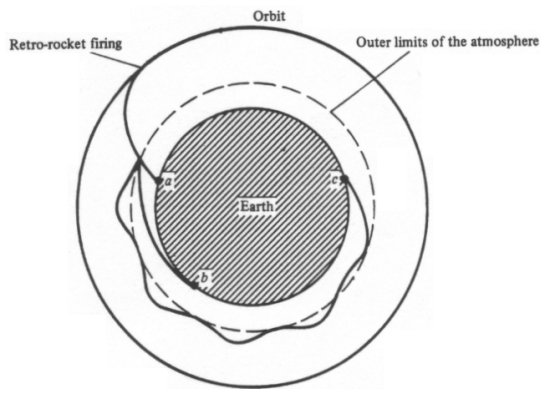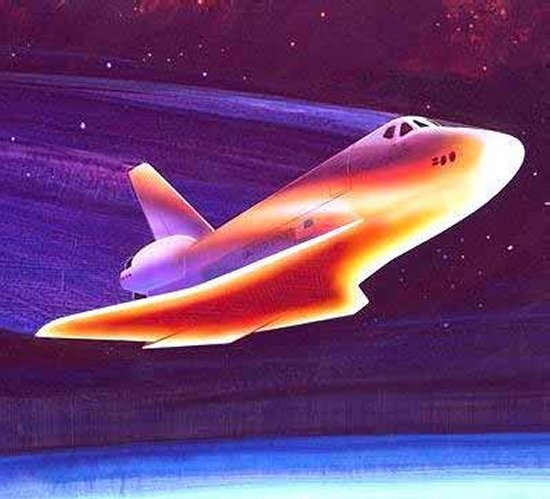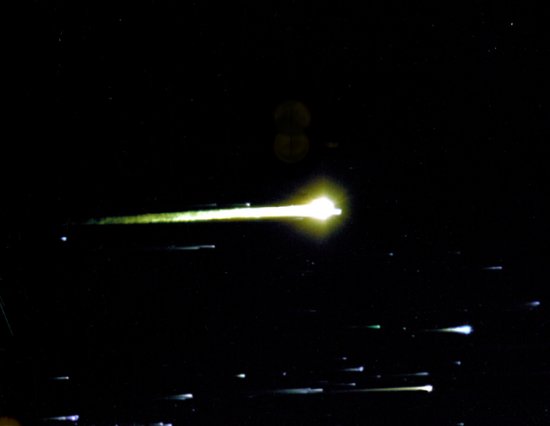|
||||||||||
|
|
||||||||||
|
||||||||||
|
|
||||||||||

The trajectory a vehicle follows when returning to Earth depends in part on the type of orbit the object traveled to reach the planet. The orbital path is significant because it determines how fast the vehicle is traveling when it first encounters the atmosphere. One special type of orbit is the circular orbit that approximates the path most spacecraft like satellites and the Space Shuttle follow while orbiting the Earth. These vehicles typically circle the Earth at speeds between 17,000 and 18,000 mph (27,360 to 28970 km/h) and will re-enter the outer fringes of the atmosphere at those high speeds.
Vehicles traveling beyond Earth orbit, like the Apollo missions to the Moon, must be launched to even greater speeds to escape the pull of Earth's gravity. Instead of traveling in circular paths, these craft follow parabolic or hyperbolic orbits that result in much higher speeds upon returning to Earth. Apollo capsules, for example, re-entered the atmosphere at speeds of nearly 25,000 mph (40,000 km/h).
A vehicle entering the atmosphere, whether it be manned or unmanned, can follow one of three different paths, like those pictured in the following diagram. The primary difference between these entry trajectories is how far the vehicle travels from the point it first encounters the atmosphere to the point where it lands. This distance is predominantly dictated by how much lift the craft generates while it travels through the atmosphere.

The vast majority of spacecraft returning to Earth follow a ballistic entry trajectory. Here, the vehicle generates very little aerodynamic lift resulting is a lift-to-drag (L/D) ratio less than 1. The craft instead plunges into the atmosphere and falls through it under the influence of gravity and drag. This drag force slows the vehicle so that parachutes can be deployed for a soft touchdown. The landing point is predetermined by conditions when the vehicle first enters the atmosphere, and the pilot has no control over the capsule's trajectory or its landing point once he leaves orbit and begins the ballistic plunge. Since the craft essentially falls vertically through the atmosphere, its downrange distance, or ground track, from the point where it first entered the atmosphere to landing is relatively small. Manned space capsules, like those used during Mercury and Gemini flights, all followed ballistic entry trajectories to a splashdown at sea. Russian Soyuz capsules continue to use ballistic entry paths today and usually touchdown on land in Siberia.
An alternate re-entry approach is the glide trajectory in which the vehicle flies through the atmosphere similarly to an aircraft. The spacecraft enters the atmosphere at a high angle of attack and generates aerodynamic lift. In so doing, the vehicle experiences a lift-to-drag ratio over 4 that allows it to travel further downrange than a ballistic capsule. The chief advantage of this technique is that the pilot has much greater control over the vehicle's trajectory and can, in theory, choose the landing site. A further advantage is that the vehicle typically lands intact on a runway and can possibly be reused again. This technique is exemplified by the Space Shuttle, the only vehicle currently employing a glide entry trajectory.

A more unusual re-entry option that merges features of both ballistic and gliding profiles is the skip entry trajectory. In this case, the vehicle first grazes the outer fringes of the atmosphere and generates drag that slows the craft down by a small amount. However, the vehicle also generates a lift-to-drag ratio between 1 and 4 and uses this lift to pitch up and leave the atmosphere again. This process is repeated several times as the craft skips along the upper reaches of the atmosphere much like a stone skipping across the surface of a lake. This skipping gradually slows the vehicle until it can safely re-enter the atmosphere and fly a more ballistic path to touchdown.
The attraction of the skip trajectory is that a vehicle can travel much farther downrange than either the ballistic or glide options allow. The primary disadvantage, however, is significantly higher aerodynamic heating since the friction heat absorbed during the skips grows at a higher rate and requires heavier shielding to protect the vehicle. As a result, skip entry has never been used for a manned spacecraft. A related technique known as aerocapture has been applied to unmanned craft, though the method is typically used to slow a vehicle and enter orbit around a planet rather than as a means of re-entry.
Regardless of the type of entry trajectory chosen, care must be taken not to decelerate too quickly or the vehicle will overheat. Humans cannot survive acceleration or deceleration rates that are too high, so manned spacecraft are generally limited to a maximum deceleration no greater than 10 g's during re-entry. Human passengers are also limited by the temperature extremes they can tolerate, so aerodynamic heating on the capsule, created by friction with the atmosphere, must be kept low enough to maintain a comfortable temperature inside. These factors become somewhat less restrictive for unmanned vehicles, but even these craft are limited in the levels of deceleration and heating they are designed to survive.

The factors we have discussed all play a role in determining how steeply an object can re-enter the atmosphere
and land safely. If the entry angle is too high, the craft will decelerate too quickly. This rapid deceleration
will generate such high g's and high temperatures that the craft will disintegrate and burn up. If the entry angle
is too shallow, the vehicle will generate too little drag and not slow down enough to follow a trajectory down to
the surface. The craft will instead skip out of the atmosphere and back into space with insufficient fuel to make
another controlled re-entry attempt. These two extremes dictate undershoot and overshoot boundaries that define
the narrow entry corridor for a spacecraft attempting to make a landing. These limits leave little margin for
error, so engineers make great efforts to ensure spacecraft are carefully guided along the proper trajectory to
survive the extremes of atmospheric entry.
- answer by Jeff Scott, 6 March 2005
Read More Articles:


|
Aircraft | Design | Ask Us | Shop | Search |

|
|
| About Us | Contact Us | Copyright © 1997-2023 | |||
|
|
|||